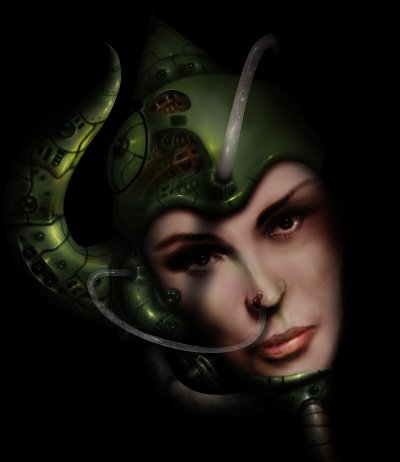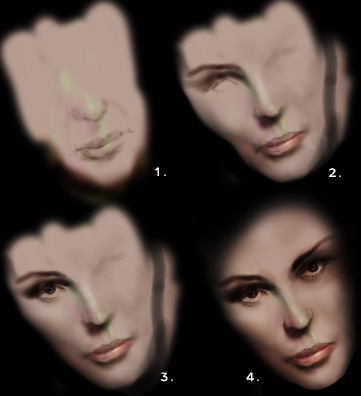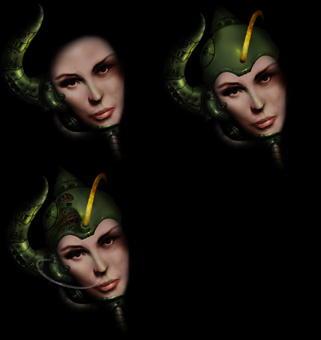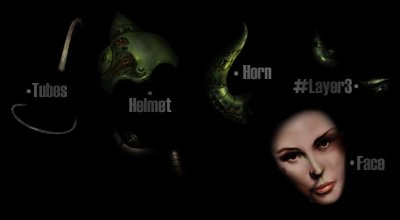GameArt Spotlight #44
"Shadows of Reality" by Petar Ivanchek

Image details
- Title: Shadows of Reality
- Gallery ID: 00774
- Artist name: Petar Ivanchek
- Posting date: 1999-11-25 (a Thursday)
- Artist website: http://derpunkt.planet-d.net
- Tags: shadows, of, reality, teaser, rpg, role, playing, games, drawings, faces, borg, aliens
- Image size: 16.53 KB
- Votes: 30
Please be sure to read the Copyright & Legal information text on the About & Help page.
Spotlight article
OK, so I finally pushed myself to make a decent tutorial on how I work and how I use colours and tools in PhotoShop. First of all, I'll introduce myself. My name is Petar "derPunkt" Ivanchek, 21 y.o. from Croatia. I study at Croatian Academy of Fine Arts and have been drawing on computer for 9 years now, 6 in Photoshop. Ofcourse, even I when started, used filters, lens flares, photos. But not any more since I now realize that filters only f..k up the realism and soul of the picture. This one was done for the new upcoming RPG "SHADOWS of REALITY" by Nevolution software, and it will probably end up as a teaser pic or we can later on use it as a concept art. I work with mouse (can't afford a decent artpad) so all of you people who curse those lucky ones who have it don't despare. We are gonna show those sissies that we worth something too =))). Ofcourse I don't scan, copy others work or work looking at some photo. Just plain mouse and PhotoShop.

Ok, what we have here are major steps in completing the face. I decided I could make a middle aged lady, but still beautiful, just to move from those sterotype-cool-looking-babe. Plus, it goes cool with that rusted steel and colours.
1. The first step isn't really a major one its just laying down broads of colour and sketching the position of eyes, lips and nose. Spend alot of time here since this is really a base of every detail. Consult a photo if you need, and put the bones on their correct spot. You can use burn/dodge for it. Don't worry if it looks awful like it looks on pic 1. just try to make the relations between eyes, nose and lips PERFECTLY correct. One thing you shouldnt forget is opening a new layer and leaving the background in colour you will use mostly (on the background ofcourse). USE ALOT OF LAYERS. Did it? OK. Lets move onto...
2. Start adding shadows and highlights KEEPING in mind from where does the light come from. * Now, I should say something. Don't use dodge/burn to shade your stuff. Its absolutely wrong. Try using airbrush set to 10% MULTIPLY with a, lets say 30% gray for shadows, and for highlights airb. set to OVERLAY with somekinda pale colour (don't use white). Don't think I didn't fell for the cool use of dodge and burn. Hell I worked like that till recently. You can see how its wrong by putting 100% orange next to 100% green. Then try to make that shape oval by burning them. You'll see how orange turns into red and green gets darker. Now thats how the shadow DOESN'T work. Try the same with MULTIPLY. * The point in laying a few colours in step 1. is to make appearance of the skin in this case more interesting and realistic. Ofcourse you can, and I STRONGLY recommend that you do, use that technique on metal, wood etc. Its just somekinda painterly approach. Now where you pointed the nose, lips, etc. start adding shadows and shape the part in mind as you wish. Try shaping lets say nose with shadows. We are gonna cheat here and we'll use smudge tool, 3-5 pixels wide rough (don't use soft). *why I say cheat about it is the fact that we are not alowed to smudge in school we shape everything with a line or colour =).
Don't draw lips with one colour only. Again use OVERLAY+MULTIPLY (set on 5-10) with some lighter shades of purple, pink and red. Now, the eyes are very tricky. They shape a face. If you make them small you'll make a piggy-mistress, and if you do them too big youll get a lady-had-a-lot-of-coffe- last-night kind of expression. Look yourself in the mirror and see how the sizes of the lips and eyes relate to each other. So, when you laid down the shadows you can use dodge/burn for fine adjustments and contrasts.
3. The face is shaping pretty nice now and we can move onto details of the eye. The most important rule is that the white part of the eye is NOT white. Eyes are always in the shadow of the forehead bones and brows. Think of them as spheres and shade in that manner. Again keep in mind the light source. In this picture shadows are strong and cover more than a half of the eye so you can't see the upper eyelid. But I did draw it and if you would brighten the picture you would see its shape. The coloured part of the eye (dunno the english word for it) is always the most entertaing part of the job. But there are some rules which we should stick to. Don't draw the outer circle then the colour circle and then the inner black circle. Make the shape of it in the colour of the eye you want and add the details with dodge/burn. There is a little trick of how to do eye real. The eye is a sphere with a hole in it and covered with a layer of "glass". Glass refracts the light rays so you have to do the same thing here. Draw the highlight of the colour part on the oposite side from where the light comes from + draw the shadows in circular way. Add some eyelashes and shadows on the root of the nose and voila. And please dont forget those little white thingies in the corner of the eyes that 90% of ppl forget. KEEP IN MIND THE LIGHT SOURCE =).
4. So, the last step in completing the face is, as you can all see, adding the other eye and fine tuning. I followed the same procedure for the other eye and worked some more on the lips shaping them so they dont look like our gal standed on the wind for 2 hours. Obviously you can see some minor changes on the nose, chin etc. OK, everything is done, and I spent some whole 3 minutes adding and adjusting highlights. You know, there is a really interesting thing happening to me when I do something. I ALWAYS test how the picture looks when brightened, darkened, inverted etc. I do that bcoz ppl have different monitor settings and if you make a picture dark on your setting someone else couldnt see shit unless he would brighten its monitor. (That thing happened to me on one competition. Picture was so dark that they couldnt see a thing on it, just a few highlights and I got disqualified. Later on I asked judges to brighten the monitor, and what happened? I could get 1st prize if I told them before. DAMN =). So, when I test my pictures I ALWAYS like what CURVE filter does it on AUTO setting. I dont use it every time, I rather do it manually. And, I always end up with a picture that has stronger contrast. OK, the face is done... Oh, who can say what I did wrong on that face? Go on, boys and girls find it.

5. The helmet, and all the other things are done JUST the same as the face. Again, broads of colour, multiply, overlay. Some dodge/burn/saturate. Oh now we come to that part I skipped on purpouse. When I work on a face, it has to look alive and colourfull and it somehow needs to move, so I work just with brushes and move the strokes freely. But, when I work on something thats technical, precise etc etc like that helmet, I use...... what? PAAAAAAATHS!!!! Thats right, paths. Paths are one GREAAAAAT thingie Photoshop has (in some recent tutorials I have seen that some guy uses Freehand to do vectors). Thats the same thing I am doing with Paths but, I think I have much more freedom with it. When you make a shape with paths, you can turn it into selection, outline it, again change it if you dont like its shape, and most of all ----- ITS ALWAYS THERE. You just have to doubleclick on #work path# and it turns into #path1# or whatever you name it. So the helmet was done in that manner as everything else except the face. Ok, we just need to add the tube stickin outta the helmet used for hormonal and oxygen feeding of the brain, add the shadows and we are DONE. I dont like the tube that much, doesnt look very realistic, but hey this is a painted picture not a photo.

So, lets take a look at exploded view of layers, as you might find it useful how I configure it. Each, lets call it a material has its own layer. Point in doing that is when you want an overall change of one material (for instance those tubes) you just modify one layer, you dont need to search thru layers seeking the corespondant part and then making the same procedure of changes all over again. So, its cool to name your layers (mine where: Background, Face, Horn, Layer 3 =), Helmet and Tubes).
Aaaaaaand, here it is. Done, finished, beaten up. Looks nice, I like it. Boy I wish I could have that cool Wacom A4 tablet and a 21" monitor. Oh yeah, forgot to say I have 14 monitor that can only run 24bit color mode in 640x480. Man I suck. Ok, I hope you all enjoyed this little Photoshop walkthru, and you all learned your lessons. If you find this information valuable show it to someone else. That would please me =). So, I think this is enough for one time, maybe Ill do another tutorial concerning, aah, dunno. Oh, dont forget to e-mail me if you have some comments or something. Or specifically job proposition, that ones I dont miss. Cheers.
Text written by Petar Ivanchek for GameArt.com

